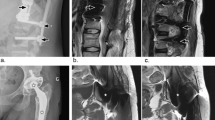Abstract
A wide variety of artifacts can be seen in clinical MR imaging. This review describes the most important and most prevalent of them, including magnetic susceptibility artifacts and motion artifacts, aliasing, chemical-shift, zipper, zebra, central point, and truncation artifacts. Although the elimination of some artifacts may require a service engineer, the radiologist and MR technologist have the responsibility to recognize MR imaging problems. This review shows the typical MR appearance of the described artifacts, explains their physical basis, and shows the way to solve them in daily practice.




















Similar content being viewed by others
References
Haacke EM, Brown RW, Thompson MR, Venkatesan R (1999) Magnetic resonance imaging: physical principle and image design. Wiley-Liss, New York
Hashemi RH, Bradley WG (2003) MRI the basics. Lippincott Williams and Wilkins, Baltimore
Bernstein MA, King KF, Zhou XJ (2004) Handbook of MRI Pulse Sequences. Elsevier, San Diego
Vlaardingerbroek MT, den Boer JA (1999) Magnetic Resonance Imaging. Springer, Berlin Heidelberg, 111–112
Pusey E, Yoon C, Anselmo ML, Lufkin RB (1988) Aliasing artifacts in MR imaging. Comput Med Imaging Graph 12:219–224
Weseby G, Adamis MK, Edelman RE (1996) Artifact in MRI: description, causes, and solutions. In: Edelman RE, Zlatkin MB, Hesselink JR (eds) Clinical Magnetic Resonance Imaging, 2nd ed. Volume 1, Saunders, Philadelphia, PA, 88–142
Arena L, Morehouse HT, Safir J (1995) MR imaging artifacts that simulate disease: how to recognize and eliminate them. Radiographics 15:1373–1394
Goldfarb JW (2004) The SENSE ghost: field-of-view restrictions for SENSE imaging. J Magn Reson Imaging 20:1046–1051
Taber KH, Herrick RC, Weathers SW, Kumar AJ, Schomer DF, Hayman LA (1998) Pitfalls and artifacts encountered in clinical MR imaging of the spine. Radiographics 18:1499–1521
Shellock FG, Morisoli SM (1994) Ex vivo evaluation of ferromagnetism, heating, and artifacts produced by heart valve prostheses exposed to a 1.5-T MR system. J Magn Reson Imaging 4:756–758
Shellock FG, Shellock VJ (1996) Vascular access ports and catheters: ex vivo testing of ferromagnetism, heating, and artifacts associated with MR imaging. Magn Reson Imaging 14:443–447
Elster AD (1993) Sellar susceptibility artifacts: theory and implications. AJNR Am J Neuroradiol 14:129–136
Czervionke LF, Daniels DL, Wehrli FW, Mark LP, Hendrix LE, Strandt JA, Williams AL, Haughton VM (1988) Magnetic susceptibility artifacts in gradient-recalled echo MR imaging. AJNR Am J Neuroradiol 9:1149–1155
Port JD, Pomper MG (2000) Quantification and minimization of magnetic susceptibility artifacts on GRE images. J Comput Assist Tomogr 24:958–964
Schiebler ML, Listerud J (1992) Common artifacts encountered in thoracic magnetic resonance imaging: recognition, derivation, and solutions. Top Magn Reson Imaging 4:1–17
Mirowitz SA (1998) Diagnostic pitfalls and artifacts in abdominal MR imaging: a review. Radiology 208:577–589
Wood ML, Henkelman RM (1985) MR image artifacts from periodic motion. Med Phys 12:143–151
Barish MA, Jara H (1999) Motion artifact control in body MR imaging. Magn Reson Imaging Clin N Am 7:289–301
Huber ME, Hengesbach D, Botnar RM, Kissinger KV, Boesiger P, Manning WJ, Stuber M (2001) Motion artifact reduction and vessel enhancement for free-breathing navigator-gated coronary MRA using 3D k-space reordering. Magn Reson Med 45:645–652
Gazelle GS, Saini S, Hahn PF, Goldberg MA, Halpern EF (1994) MR imaging of the liver at 1.5 T: value of signal averaging in suppressing motion artifacts. AJR Am J Roentgenol 163:335–337
Larkman DJ, Atkinson D, Hajnal JV (2004) Artifact reduction using parallel imaging methods. Top Magn Reson Imaging 15:267–275
Mitchell DG (1992) Abdominal magnetic resonance imaging: optimization and artifact suppression. Top Magn Reson Imaging 4:18–34
Peh WC, Chan JH (2001) Artifacts in musculoskeletal magnetic resonance imaging: identification and correction. Skeletal Radiol 30:179–191
Wehrli FW, Perkins TG, Shimakawa A, Roberts F (1987) Chemical shift-induced amplitude modulations in images obtained with gradient refocusing. Magn Reson Imaging 5:157–158
Hood MN, Ho VB, Smirniotopoulos JG, Szumowski J (1999) Chemical shift: the artifact and clinical tool revisited. Radiographics 19:357–371
Boland GW, Lee MJ (1995) Magnetic resonance imaging of the adrenal gland. Crit Rev Diagn Imaging 36:115–174
Venkataraman S, Braga L, Semelka RC (2002) Imaging the fatty liver. Magn Reson Imaging Clin N Am 10:93–103
Schwaighofer BW, Yu KK, Mattrey RF (1989) Diagnostic significance of interslice gap and imaging volume in body MR imaging. AJR Am J Roentgenol 153:629–632
Kneeland JB, Shimakawa A, Wehrli FW (1986) Effect of intersection spacing on MR image contrast and study time. Radiology 158:819–822
Heywang-Kobrunner SH, Wolf HD, Deimling M, Kosling S, Hofer H, Spielmann RP (1996) Misleading changes of the signal intensity on opposed-phase MRI after injection of contrast medium. J Comput Assist Tomogr 20:173–178
Author information
Authors and Affiliations
Corresponding author
Rights and permissions
About this article
Cite this article
Stadler, A., Schima, W., Ba-Ssalamah, A. et al. Artifacts in body MR imaging: their appearance and how to eliminate them. Eur Radiol 17, 1242–1255 (2007). https://doi.org/10.1007/s00330-006-0470-4
Received:
Revised:
Accepted:
Published:
Issue Date:
DOI: https://doi.org/10.1007/s00330-006-0470-4




